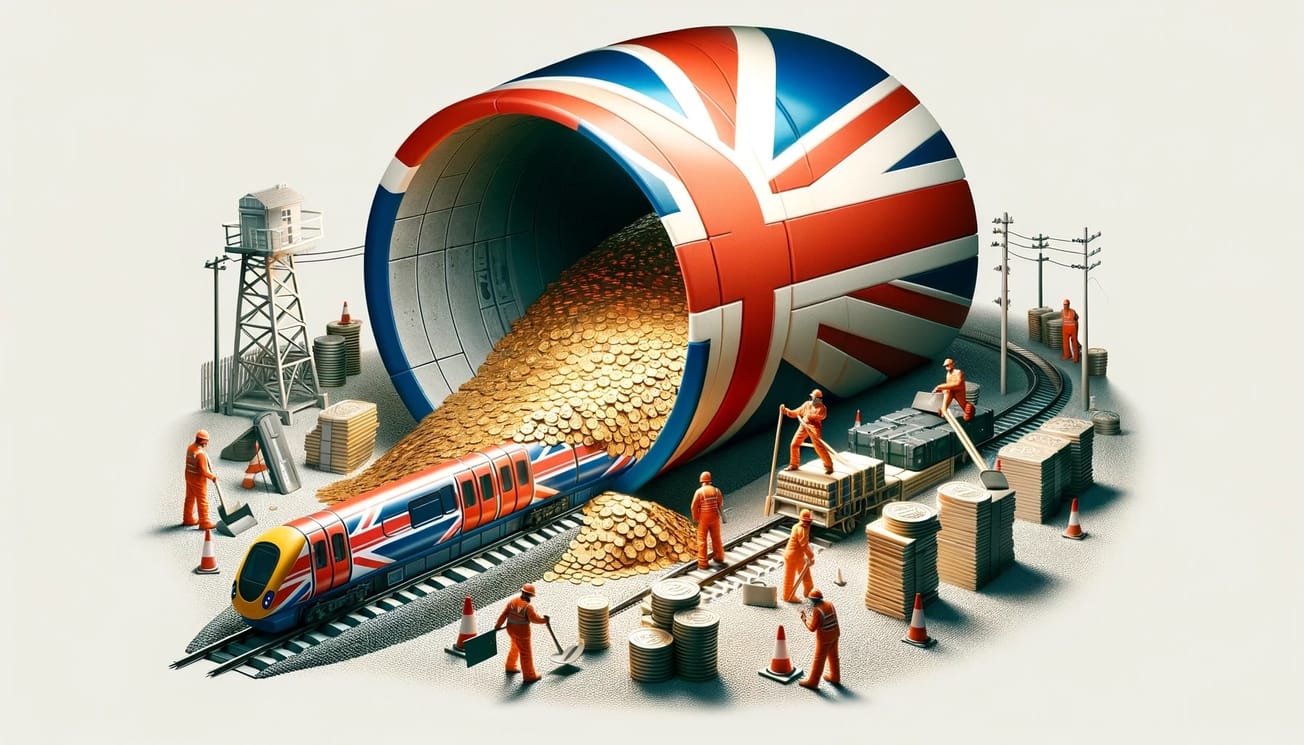

+ Over the past three decades, the UK has faced challenges in updating its infrastructure, lacking the ambition, funding, and political backing to undertake larger projects and keep pace with global progress.
+ A few critical--but addressable--challenges are scuttling large scale projects like High Speed Two (HS2), including over-specification, over-engineering, NIMBYism and local politics, a lack of consistency in decision making, and some unfortunate if understandable sources of cost escalation.
+ Frequent changes and cancellations of UK infrastructure projects are causing doubts about the country's planning and construction capabilities, leading to increased business uncertainty. This uncertainty can deter future bids from contractors and lessen both domestic and foreign investments, now often viewed as too risky.
+ As the UK recovers from COVID and adjusts to life after Brexit, reliable and timely infrastructure projects are crucial. They attract investment, spur economic growth, and create jobs, demonstrating the need for effective project management and execution.
Late and over budget: the case of HS2
The United Kingdom’s approach to infrastructure has grown increasingly strained over the last 30 years. As new infrastructure is needed for a world that is constantly advancing, the UK has struggled to find the ambition, funding, and political will to turn ideas into reality. Since the completion of the Channel Tunnel in 1994, some of the UK’s efforts to build modern day infrastructure have been amongst the most delayed and expensive on Earth, from the Holyrood Project through to Crossrail. High Speed Two (HS2) is another in a long line of problematic infrastructure projects, which raises the question: Why does the UK have such a poor record of building infrastructure projects?
HS2 was a planned railway line currently under construction, originally designed to connect London to the North of England via Birmingham with trains running at a maximum speed of 225mph. As one of the largest infrastructure projects in the UK’s history, the project has not been without problems; spiraling costs, delays, and opposition from various groups have all contributed to a downturn in support for the project since its beginnings in 2009. This erosion of support culminated in the cancellation of Phase 2 of the project in October 2023, leading to confusion and uncertainty for businesses involved in its development.
Why does the UK have such a poor record of building infrastructure projects?
Due to the need for expensive infrastructure to win headlines, there is a systematic tendency to over-specify. One of the HS2’s most well-known features is that it will travel at over 200mph, whilst lower speeds would be much less costly and would only increase journey times slightly. Additionally, the focus on speed drew attention away from the project’s main benefit, which was an increase in railway capacity. This meant the general public were not as informed about the reasons for the project, and this contributed to their apathy toward HS2.
One of the key reasons that the UK struggles to build infrastructure is an attraction to perfection rather than practical designs that would simply work for the job they are designed to perform. HS2’s former technical director Andrew McNaughton named this as one of the principal failures of HS2, saying “If you assure it, you have to produce absolutely bomb-proof designs and that's called, in my book, overengineering.” McNaughton also said that this problem is seen in much smaller infrastructure projects too, such as the current struggles to electrify railway lines across the country.
The HS2 line between London and Birmingham runs through many constituencies represented by influential Conservative party backbenchers...This resulted in long underground tunnels being built for the railway to run through, at substantial additional cost.
Another key reason behind the difficulties is the planning process for large infrastructure in the UK, which gives a disproportionate amount of power to minority interests. In order to gain planning approval, concessions are made to appease individuals and small communities, often at enormous cost. Known as “NIMBYs” (Not In My Back Yard), this is a characterisation of the opposition that communities may have toward developments in their area, particularly if they do not directly benefit the communities themselves. The HS2 line between London and Birmingham runs through many constituencies represented by influential Conservative party backbenchers, who understandably did not want a railway running through their communities with little benefit to them. This resulted in long underground tunnels being built for the railway to run through, at substantial additional cost. The UK has previously struggled with keeping costs down for large tunneling projects, as seen with the Jubilee Line Extension and Crossrail both being over budget by more than 20%. This decision was, therefore, always likely to result in cost challenges for HS2.
The lack of consistency in decision making also led to constant rescoping and reapprovals, and subsequent redesigns. This meant that delays grew, and costs went up further, which then led to a cycle of hesitation over costs, leading to increased delays and costs, which in turn leads to more hesitation. In order to construct infrastructure on this scale, decision making must be clear from the start, with any changes being made to design prior to construction beginning, rather than changes being made throughout the course of the project.
Cost escalation
The project has been a victim to fluctuating inflation rates since the first cost estimate of £37bn was made in 2010. This cost may have risen to £106bn in the subsequent ten years, which, even when accounting for inflation, would still be around £87bn in 2010 prices. The doubling in cost can be explained partly by three factors.
The first reason is the huge rise in land prices in the UK since the project was first designed. UK house prices have risen much faster than the rate of inflation, with the average UK house rising in price by 71% from 2010 to 2023. This means that the costs of buying the land needed to build the railway have also soared, causing a huge increase to the cost of HS2 overall. This also harms the business case for the railway, as the UK is much denser than other countries with high-speed railways, and therefore the relative benefit is much lower than for other countries as the average distance that people will travel at high speeds is lower.
The second factor is a lack of experience in building similar infrastructure projects. This extends to a lack of skills, lack of machinery, and a lack of personnel, and builds on the basic rule of economies of scale; as you build more, the better and cheaper it becomes. If industry knowledge becomes better, workers do not need to continuously learn new skills and the methods used in future infrastructure projects are easier to reproduce. For HS2, the project had to start from close to none of this experience, meaning much more pressure was put on existing supply chains. Diseconomies of scale due to shortages pushed prices of labour and material up, which in turn pushed up the cost of the project. Countries such as France, with vast high speed rail networks of their own, have built lines at costs of close to £50m per mile, but HS2 between London and Birmingham is estimated to cost 7 times more. Experience and economies of scale have an outsized impact on cost.
The third factor is the impact of the delays caused by convoluted planning processes discussed earlier. Each delay leads to complications, which in turn lead to the impact of inflation being much greater. In order to cut costs, it is vital that delays are significantly reduced.
Broad impacts on businesses
Changes, amendments, and cancellations to large scale projects all raise issues about the UK’s ability to plan and construct infrastructure, and from there its ability to deliver in other areas, amplifying business uncertainty. In particular, this uncertainty may dissuade future contractors from bidding on other projects, or reduce the likelihood of both domestic and foreign private investment, due to its perceived risk. Additionally, thousands of small businesses had begun to invest in their local areas on the basis that HS2 would reach the North-West of England. These small businesses now face an uncertain future, with little return for their investment. As the UK continues to recover economically in the aftermath of the COVID pandemic and the impact of Brexit, infrastructure projects will be key in securing the private investment needed to stimulate growth and create new jobs. The UK must demonstrate its ability to construct on time and to budget in order to give businesses the certainty they need.
As the UK continues to recover economically in the aftermath of the COVID pandemic and the impact of Brexit, infrastructure projects will be key in securing the private investment needed to stimulate growth and create new jobs.
The impact on freight is the loss of opportunity that would have existed had HS2 been built to its intended design, and the lower productivity that comes with it. In particular, the benefit to the UK’s rail freight capacity will be much lower, at a time when rail freight is already constrained. The number of freight train movements has dropped by nearly 50% between 2004 and 2019. The construction of HS2 in its entirety would have created space for up to 144 extra freight trains per day, meaning the network would be less constrained, productivity would increase, and there would be a boost to the economy across the UK. Additionally, each train would equate to 76 heavy goods vehicles being taken off the road, contributing to a cut in carbon emissions at a time when the UK is aiming to decarbonise and reach net-zero by 2050. This demonstrates that a failure to invest fully in infrastructure projects can lead to the loss of opportunities across multiple different sectors.
The cancellation of HS2 represents another failure to deliver UK infrastructure on schedule and to budget. The failure to make consistent decisions, overengineering, and rising costs have all contributed to the increased business uncertainty and the failure to capitalise on opportunity. However, by learning from the mistakes of previous failings, the UK can make systemic changes toward better infrastructure delivery, and thereby generate greater private investment that comes with it. The UK must be proactive in its approach to infrastructure, making bold and consistent decisions, and pursuing them until completion to build a stronger base for economic prosperity and development.








